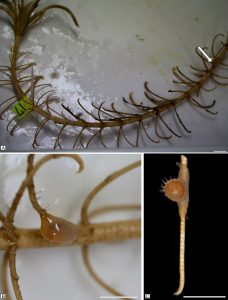Prof. Mikołaj Zapalski from the UW Faculty of Geology with researchers from Japan and Poland described an ecological “living fossil” unseen for 273 million years. Their article appeared in “Palaeogeography, Palaeoclimatology, Palaeoecology”.
Palaeozoic seafloors were inhabited by numerous organisms interacting with each other. One of these associations was corals growing on sea lilies (crinoids). As corals grew on crinoids, they were lifted above the seafloor, thus profiting from stronger feeding currents. Fossils of crinoid-coral associations are known from Palaeozoic rocks, and the youngest are known from rocks dated from ca. 273 million years ago. While both corals and crinoids are known from younger rocks, such associations are unknown neither from Meso- and Cenozoic strata nor contemporary seas.
In a research article, Prof. Mikołaj Zapalski from the UW Faculty of Geology with collaborators from Japan and Poland described an ecological “living fossil” unseen for 273 million years; non-skeletal corals growing on crinoid stalks. The investigated animals were collected from depths exceeding 100 m near the Pacific coasts of Honshu and Shikoku. The research was conducted using microtomography scanning and revealed that, unlike their Palaeozoic counterparts, recent corals do not modify the host’s skeleton. Despite such differences in the skeletal record, the newly discovered coral-crinoid associations may serve as a good model of relevant Palaeozoic interactions.
The paper has been published in “Palaeogeography, Palaeoclimatology, Palaeoecology”. Other scientists involved in the research: Prof. J. D. Reimer, Dr. Hiroki Kise and Dr. Takato Izumi from the University of the Ryukyus, Dr. Ryuta Yoshida from the Ochanomizu University, and Dr. eng. Marek Dohnalik from the Oil and Gas Institute – National Research Institute.



